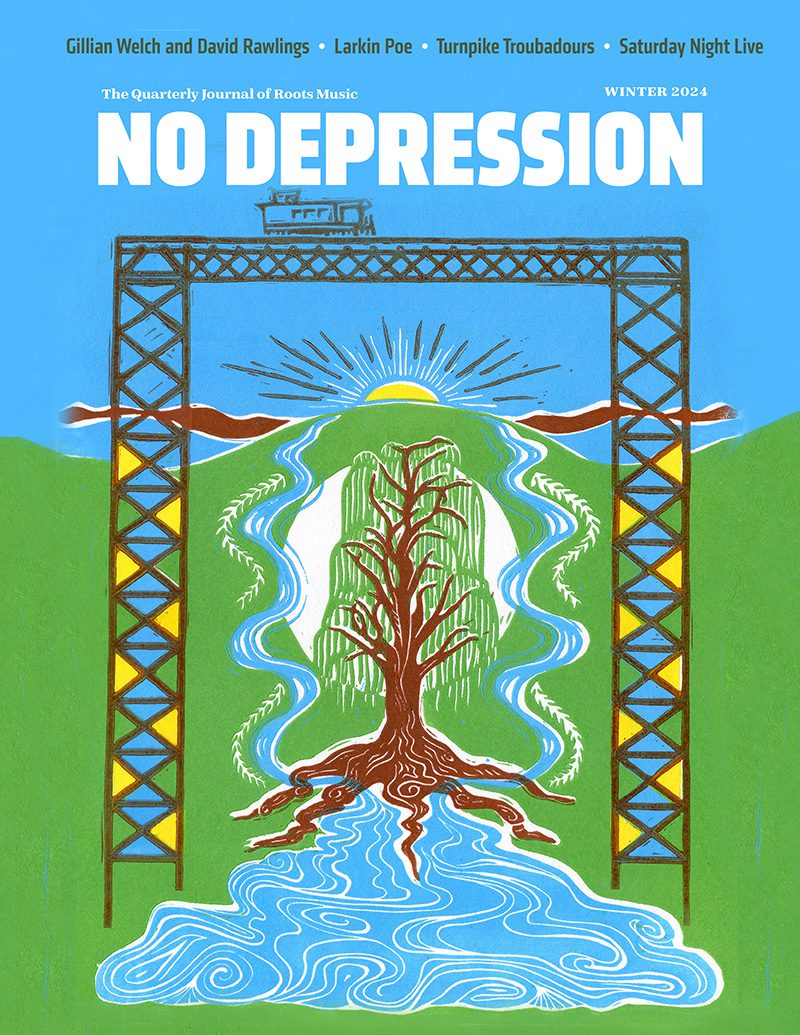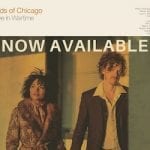Catchin’ an all-night station
Somewhere in Louisiana
It sounds like 1963
But for now
It sounds like heaven.
–“Windfall,” Son Volt
It’s a warm, incandescent, comforting burnt-orange blur. The slim needle of the AM radio dial in that old Chevy stationwagon, dimly lighting the dashboard as we coasted along the winding river road, heading home from another serene Sunday afternoon at the lake. The flickering embers of a once-blazing fire at summer camp years ago. The soft glow of the cathode-ray tube glimmering through cracks in the back of the old black-and-white, fading ever so slowly even after we had switched off the set and drifted into dreams.
“Trace” — definition eight, Webster’s New World: a) the visible line or spot that moves across the face of a cathode-ray tube; b) the path followed by this line or spot. Definition number one: A way followed or a path taken.
It’s a fitting title for the debut album by Son Volt, the path taken by Jay Farrar after he left Uncle Tupelo in the spring of 1994. The band appeared to be poised at the brink of a commercial breakthrough when Farrar simply up and split, to the surprise of seemingly everyone except himself.
Perhaps all’s well that ends well. Jeff Tweedy and the other Tupelo members have found a new groove as Wilco, mining Tweedy’s more pop-oriented songwriting instincts to a fuller extent, yet still mixing in the traditional instrumentation and influences that made Uncle Tupelo the beacon of a dynamic and substantial country-rock revival. It took some gumption for Tweedy to take the wheel and steer Wilco back onto the highway, but he’s done it.
Farrar, meanwhile, has headed for the back roads with Son Volt. Sometimes it’s wide-open stretches of rural two-lane with the pedal to the floor: “Live Free,” “Route,” “Drown,” “Loose String” and “Catching On” burn rubber with the intensity of a desperate man fleeing the scene of disaster. But there comes a time for quiet reflection. “Windfall,” “Tear Stained Eye,” “Ten Second News,” “Out of the Picture” and “Too Early” take a turn down rambling dirt roads, where the dust of dobros and fiddles and accordions and steel guitars is carried off by a wind that takes your troubles away, way down into the streets of the smallest towns in America.
Flat River. Times Beach. Ste. Genevieve. Festus. Farrar.
Yes, Farrar — population 90, Perry County, Missouri. It’s one of several tiny burgs south of St. Louis that comes up in an interview with Farrar a few weeks before the release of Trace, the band’s debut album for Warner Bros., due out September 19th.
“My dad has a hat from that town, from some general store or something like that,” Farrar says, though he’s unsure if there’s any tie between Farrar, Missouri, and his family history. “I don’t really know; I think my dad’s family is from around that part of the state, though.”
Notoriously tight-lipped in interviews — not because he’s rude or insensitive, but just because he apparently prefers to let his music do the talking — Farrar does manage to open up ever so slightly when our conversation turns to small-town stories and myths. Like the place where Trace was made. “We recorded at a studio in Northfield, Minnesota. I guess Northfield is the place where the James Gang got turned back by the locals. The studio’s across the street from a bank where they still have bullet holes circled in the wall outside, supposedly bullets from the James Gang.”
Another anecdote relates more directly to the music. When I ask Farrar about one of the most memorable lyrics on the new album — “There’s a beach there known for cancer waiting to happen,” from the hauntingly hushed “Ten Second News” — he readily offers up the inspiration for the line. “There’s a place off of Interstate 44 (in Missouri) on the Meramec River, a town called Times Beach. I guess years ago it had dirt streets, and someone had sprayed oil on the streets to keep the dust down, and the oil had dioxin in it. And then when the river flooded once, the whole town had to be evacuated. So it’s a ghost town now. And I think they’re building some kind of incinerator there now to burn off all the topsoil and debris that’s dioxin-tainted.”
Not that the entire song is necessarily about that. The biggest difference between Farrar and Tweedy as songwriters is that Tweedy generally takes an up-front and straightforward approach, whereas Farrar’s lyrics are couched in poetry, imagery and metaphor. Exactly how the Times Beach tragedy relates to a chorus that simply states “Only you’ll ever know / As day by day disappears / Only you’ll ever know” is a mystery — but it’s the feel, the emotion, that counts, and Farrar delivers that in spades.
Even more oblique is “Tear Stained Eye”, which mentions Ste. Genevieve, a small town (pop. 4,411) on the banks of the Mississippi River. “It’s a historic town, and in the song, it’s just referring to the fact that every time the river floods, the town is in danger of being flooded,” Farrar says. Which doesn’t quite explain the line in the chorus: “Ste. Genevieve can hold back the water, but saints don’t bother with a tear stained eye.” And it doesn’t need to, what with equally elusive but beautiful lines in the verses such as “I will meet you anywhere the western sun meets the air.”
As for Flat River and Festus: The former is the town where Farrar was heading the day after our interview to meet up with his bandmates — brothers Jim and Dave Boquist of Minneapolis, and former Tupelo drummer Mike Heidorn of Belleville, Illinois, who has rejoined his old friend after a couple years of domestic anonymity. Flat River (pop. 4,823) is the site of a rehearsal space normally occupied by the Bottle Rockets, who hail from nearby Festus (pop. 8,105).
Between the two of them, the Bottle Rockets and Uncle Tupelo were the much-ballyhooed St. Louis country-rock scene of the late ’80s and early ’90s, even though neither of them actually lived in St. Louis (Heidorn, Farrar and Tweedy all had addresses across the state line in Belleville). “A the time we were getting into it, St. Louis had the worst music scene in the world,” says Brian Henneman, guitarist and primary songwriter for the Bottle Rockets. “We always played on the same bills with Uncle Tupelo because we were the only two bands that they could figure out to put together. Because there was nothing else going on like that in St. Louis.”
What the scene lacked in quantity, it more than made up for in quality. It was clear from Uncle Tupelo’s first album, 1990’s No Depression, recorded when Tweedy and Farrar were barely old enough to drink (though age regulations probably didn’t stop them in those notoriously hazy days), that we were witnessing the development of a great American rock band. From the anthemic opening lurch of “Graveyard Shift” to the perfect porch-song closer “Screen Door,” and spotlighting a brilliant exhumation of an old Carter Family chestnut (the title track), No Depression was the launching pad for what has now become a bona fide movement.
The 1991 follow-up Still Feel Gone kept the ball rolling in the same direction, with Tweedy’s passionate “Gun” and Farrar’s aching “Still Be Around” highlighting another solid collection of hard and heartfelt tunes. But Farrar and Tweedy were wise enough to avoid falling into a rut and subsequently made their third album, March 16-20, 1992, an all-acoustic affair produced by R.E.M.’s Peter Buck. The next step was a move to the majors: Sire/Reprise signed Uncle Tupelo and released Anodyne, which found the trio expanding to a quintet and striking an ideal balance between its acoustic and electric personas.
In the meantime, Henneman — who had toured with Uncle Tupelo as a guitar tech and contributed mandolin, banjo, bouzouki and slide guitar parts to the acoustic album — began gearing up for his own career by assembling the Bottle Rockets from former members of his old band, Chicken Truck. When their debut album came out on East Side Digital in 1993, the St. Louis — er, suburban-St. Louis — scene seemed primed to recharge the new alternative mainstream with a two-pronged assault of country-tinged rock ‘n’ roll.
And then Farrar quit Uncle Tupelo.
To this day, the reasoning behind his decision remains hidden to about everyone but Farrar. “It’s as big a mystery to me as anybody, and I was pretty much hanging out with them during that whole time,” Henneman told me in a recent interview. “I don’t know what the heck ever came between ’em to make ’em split up. It was like, out of the blue, they were gone. And I thought they were set to really do something huge.”
Even Tweedy appears to have been in the dark about it, judging from the honest bewilderment he has expressed in Wilco interviews when the subject of his old band is raised. “I think it was a personal decision for Jay, but he wasn’t very communicative about anything to us, which was fairly normal for Jay,” Tweedy told Alan Sculley of the St. Louis Post-Dispatch in April. “I mean, a lot of things that were used as explanations were fairly contradictory, so I really wouldn’t be able to comment on it.”
For his part, Farrar pretty much sticks with the straight “artistic differences” party line. “It just seemed like it reached a point where Jeff and I really weren’t compatible,” he says. “It had ceased to be a symbiotic songwriting relationship, probably after the first record.”
Looking to the music for clues is always a dicey proposition — it’s easy to misinterpret lyrics or read too much into them — but it seems reasonable to suspect that the Son Volt song “Drown” might deal with Farrar’s departure from Uncle Tupelo: “When in doubt, move on / No need to sort it out.” Maybe it was just that simple.
For Farrar, moving on included relocating from Belleville to New Orleans. “It’s been about a year, last August,” he said. “My girlfriend got a job down here. And I was ready to do it.”
Musically, Farrar says he didn’t have any sort of master plan in mind when he left Uncle Tupelo. “I just knew that I had the songs, and I felt fortunate that I had an outlet for the songs,” he says. “I feel fortunate that I met Jim and Dave, and of course Mike.”
The Boquist brothers entered the picture as a result of an Uncle Tupelo tour with Joe Henry, for whom Jim had been playing bass. “When the tour was ending, we all exchanged numbers and everything,” recalls Jim, a veteran of mid-’80s Minneapolis band the Mofos who more recently had gigged with current Jayhawks drummer Tim O’Reagan. “And then I went down and saw an Uncle Tupelo show in Des Moines; this was after Joe Henry had finished touring with them. I basically went to visit, and I had a drink with Jay later on that night. This was not long after certain decisions had been made [about Farrar’s departure from Uncle Tupelo]. He had some recording he was going to be doing, and he asked me about doing it. And I said that if I could, I would.”
When Farrar began looking for another guitarist who could also play instruments such as fiddle and banjo, the natural choice was Jim’s brother Dave, who had met Farrar once at a show in Minneapolis. “I’m not really sure how we all got connected, but it just sort of all made sense,” says Dave, who spent the early ’90s playing with Minneapolis band John Eller & the DTs. “Jay and I were talking, and I think Jay was talking to my brother, and my brother was talking to me. It’s kind of a small world up there in Minneapolis.”
Playing with Farrar seems almost a stroke of destiny for Dave, who grew quite attached to Uncle Tupelo’s Anodyne while on vacation in France in the winter of ’93/’94. “It was an album that kind of carried me through a lonely time in Paris,” he remembers. “I thought it was just a beautiful record.”
Drummer Mike Heidorn, of course, had much deeper attachments to Uncle Tupelo’s music. Heidorn left the band a couple months after the recording of the March 16-20, 1992 album, a decision he says was prompted by conflicts between a family and a career. “I had just gotten married, and we have a couple of kids, and I didn’t really want to hold the band back in getting their music out and all that stuff,” he says. “We had some offers from some bigger labels, and Jeff and Jay were writing some really good songs, and I figured maybe they could use somebody at that juncture who could just go, go, go.”
Ironically, it was Heidorn’s wife who encouraged him to get back in the music business when the opportunity to work with Farrar again arose last year. “I had pretty much clocked out and never thought about it at all until Jay had this album to do. And my wife was actually talking to me and said something like, ‘Give him a call, see what he’s doing.’ So I just called to see if he needed any help to record …. and he said, ‘Sure.’ “
For Heidorn, playing drums in Son Volt has been like slipping back into a comfortable old sneaker. “I’ve only played with him or Jeff in my life, so I just fell into automatic mode. I guess it was just like I thought it would be.”
It’s mid-June of ’95, and Son Volt is onstage at 7th Street Entry, kicking off a two-night stand at the storied Minneapolis club. They had played an impromptu acoustic gig at the Uptown a couple nights earlier, but for all practical intents and purposes, these are their debut live performances, their first chances to showcase the songs they had recorded a few months earlier in the studio across the street from the bank with the bullet holes of the James Gang in the wall.
The band is tight — maybe a little too tight, perhaps a shade nervous about their first gig, concentrating on playing everything right. But it hardly matters. When you’ve got a guy who may well be the best songwriter of his generation at the helm, it’s hard to go wrong.
They run through a set of about 20 tunes, including nearly everything from Trace and a well-chosen smattering of Tupelo standards — “Grindstone,” “Slate,” “True To Life,” “Fifteen Keys,” “Chickamauga” among them. A few overzealous fans call out way too many times for “Whiskey Bottle”; Farrar skips it the first night and plays it the next, probably because nobody screams for it.
But it’s the new songs I’m digging most. At that point, I had listened to Trace only a couple times, yet it was clear that every song on it was a keeper. The urgently crashing “Drown” hooks you in so instantly that these guys may well have a hit single on their hands. The heartstopping ballad “Too Early” addresses the tragedy of burning out too brightly as eloquently as any song ever written (and I’ll bet my bottom dollar it’s about Townes Van Zandt, by the way). “Live Free” shows the other way to go, and how that move to Louisiana has given Farrar room to grow: “Someday we’ll be together, farther south than the train line / The Delta mud will be there …. The rhythm of the river will remain.”
And then there’s “Windfall,” the first song on the record and an instant classic if ever I’ve heard one. It shines with an irrepressible warmth and a truer sound, like the TV’s glowing cathode-ray tube, the AM radio in the dashboard, the ashes from the dying campfire drifting into the distance on a southbound summer breeze. May the wind take your troubles away.




